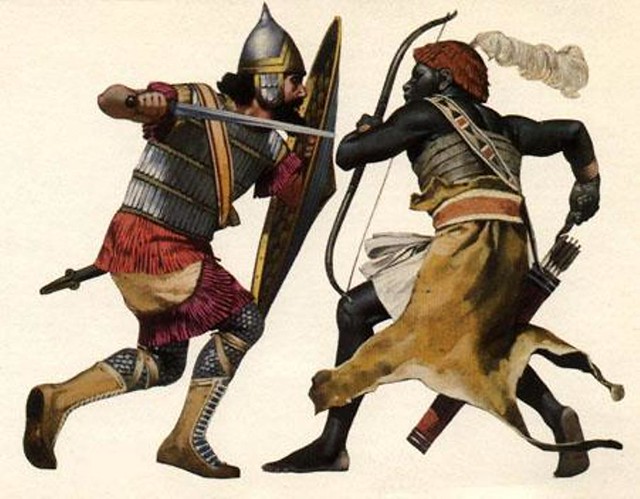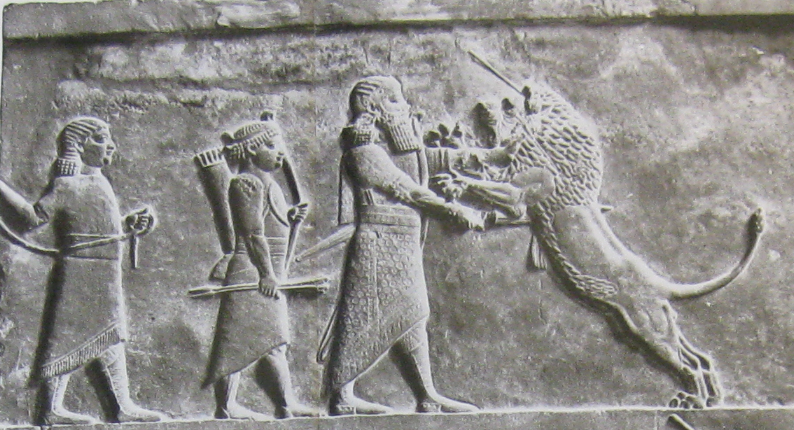| Author |
Message |
|
Julian Bickers
Location: London, UK Joined: 24 Feb 2011
Posts: 1
|
 Posted: Sat 05 Mar, 2011 7:06 am Post subject: Assyrian long sword Posted: Sat 05 Mar, 2011 7:06 am Post subject: Assyrian long sword |
 |
|
Hi, forum and site noob here so apologies in advance if this has been covered before.
I'm looking for the name, details and characteristics of the Assyrian long sword. I've seen some chatter on this site about the Assyrian Sappara but from looking at the orthostats in the British Museum taken from Nineveh and elsewhere the infantry are clearly armed with a long, straight sword. This appears to have been quite heavy as it was supported not just by a belt but a shoulder strap also and, interestingly, seems to be a side arm.
I see nothing else like this in other cultures at the same time and place.
Any ideas?
|
|
  |
 |
|
Sander Alsters
Location: Netherlands Joined: 03 Jun 2009
Posts: 54
|
 Posted: Sun 06 Mar, 2011 1:40 am Post subject: Longsword Posted: Sun 06 Mar, 2011 1:40 am Post subject: Longsword |
 |
|
Hi Julian,
from what I've been reading from the book Arms and Amours from Iran written by Manouchehr Moshtagh Khorasani, there were indeed longswords used in that time. He discripes mostly Achemenian and Median Akenakes and other different daggers and swords. Although their timeperiod is'nt that far appart, maybe its safe to assume swords didn't change that much.
He discripes findings of longswords from about 54 to 59 cm. The others are much shorter. One of them is nicely decorated with steel and bronze nails. They use wood for the grip and mostly mushroom or crescent shaped pommels.
There are others in his book though, I will discripe you a sword from an excavation in Amarlu(Northern Iran). It was the longest I could find atm.
The sword is from around 1000BC. It lays in the national museum of Iran. (inventory number:1284m).
The sword has a iron blade and a bronze handle. His total length is 104.5cm The blade lenght is 74.5cm The handle 30cm. the width of the blade at the base is 4 cm and in the middle 3.2cm the sword weight is 1180grams.
I hope this helps you in a way?
Kind regards,
Sander
|
|
   |
 |
Shahril Dzulkifli

|
 Posted: Sun 06 Mar, 2011 7:23 pm Post subject: Assyrian long sword Posted: Sun 06 Mar, 2011 7:23 pm Post subject: Assyrian long sword |
 |
|

An Assyrian soldier fighting a Nubian archer by Angus McBride.
And folks, that's the only reference on the Assyrian long sword I can give.
“You have power over your mind - not outside events. Realize this, and you will find strength”
- Marcus Aurelius
|
|
  |
 |
|
Gregory J. Liebau
Location: Dinuba, CA Joined: 27 Nov 2004
Posts: 669
|
 Posted: Sun 06 Mar, 2011 8:29 pm Post subject: Posted: Sun 06 Mar, 2011 8:29 pm Post subject: |
 |
|
Might I suggest you ask this question in the Near Eastern forum over at the Bronze Age Center? We have a couple of members who specialize in Assyrian studies, but I don't believe either of them post here on myArmoury. Cheers.
-Gregory
The Bronze Age Center
(p.s. You'll need your account confirmed before you can finalize your registration. I check it regularly so it shouldn't take too long.)
|
|
  |
 |
Jamie Szudy

Location: Malaga Spain & Madison, Wisconsin Joined: 23 Mar 2011
Posts: 15
|
 Posted: Wed 23 Mar, 2011 5:23 pm Post subject: Posted: Wed 23 Mar, 2011 5:23 pm Post subject: |
 |
|
As far as I know, there are no preserved Assyrian iron longswords. IIRC, there is a long, thin inscribed bronze Assyrian sword from the mid 2nd Millennium BC. Unfortunately, I can't for the life of me remember where I saw it. 
Also, as far as I know, there was no special word for them. A sappara was essentially the same as an Egyptian Khopesh (some refer to this as a sickle-sword, but this is a misnomer - it is the OUTER curve of the blade that is sharp, not the inner. The khopesh/sappara is actually a sort of cross-breed beteen axe and sword).
The standard word for "sword" in Akkadian was patru (usually written with the logogram GIR2), however, as far as we can tell from the texts, the usage of the term was no more specific than "sword" is in English. It could refer to the short-swords used by common soldiers (so short that patru is often translated as "dagger") as well as the long swords worn by higher-status individuals.
Pretty much all we know about the long swords is what can be gleaned from depictions of them. There are innumerable such depictions to be found on Assyrian palace reliefs, and they seem to be something of a status symbol. The high-status people (the king & princes, courtiers, noblemen, commanders, etc.) seem to carry the longest, most ornate ones. There also seems to be a general tend towards shorter swords later in the period (which spans about 850-600 BC), though some long ones do appear.
Interestingly enough, in all the battle scenes depicted in Assyrian reliefs, I don't believe I've even seen a long sword shown drawn or being used in combat (there is a single depiction of Assurbanipal stabbing a lion with one in a hunting scene from the North Palace at Nineveh). Short swords are very commonly shown being used, but the long ones always appear sheathed. Often the people wearing them, riding in chariots or o foot, are firing their bows instead, however it does seem odd that they are never shown in use. Perhaps they felt the image of them firing a bow seemed more heroic than hacking away with their swords. Assyrian iconography does seem to rather fixate on the bow as the image of military power (though, oddly enough, iron swords are the preferred textual symbol of military power).
Assyrian swords were always hung on a baldric, regardless if whether or not they were short or long swords, simply because they had not developed a sword-belt. The belts that were in fashion at the time were very wide and made of fabric, not unlike a cumberbund, and may not have been suitable for hanging weapons from.
If you reach Oakeshott's Archaeology of Weapons, he points out some marked similarities between Assyrian long swords as depicted on reliefs and Hallstatt swords. He may overstate their similarities a bit, but the general shape of the hilts and especially the wide “winged” chapes (which Oakeshott believed were hooked behind the calf to allow one to draw the sword with a single hand, not having to grasp the sheath) are indeed quite similar.
The following pics are from Layard’s Monuments of Nineveh, published in 1853, all of which I believe come from the Northwest Palace of Assurnasirpal (ruled 883-859 BC) at Nineveh.



The only scene I have found of an Assyrian long sword in use: Assurbanipal stabs a lion

|
|
  |
 |
|
|
You cannot post new topics in this forum
You cannot reply to topics in this forum
You cannot edit your posts in this forum
You cannot delete your posts in this forum
You cannot vote in polls in this forum
You cannot attach files in this forum
You can download files in this forum
|
All contents © Copyright 2003-2025 myArmoury.com — All rights reserved
Discussion forums powered by phpBB © The phpBB Group
Switch to the Basic Low-bandwidth Version of the forum
|

